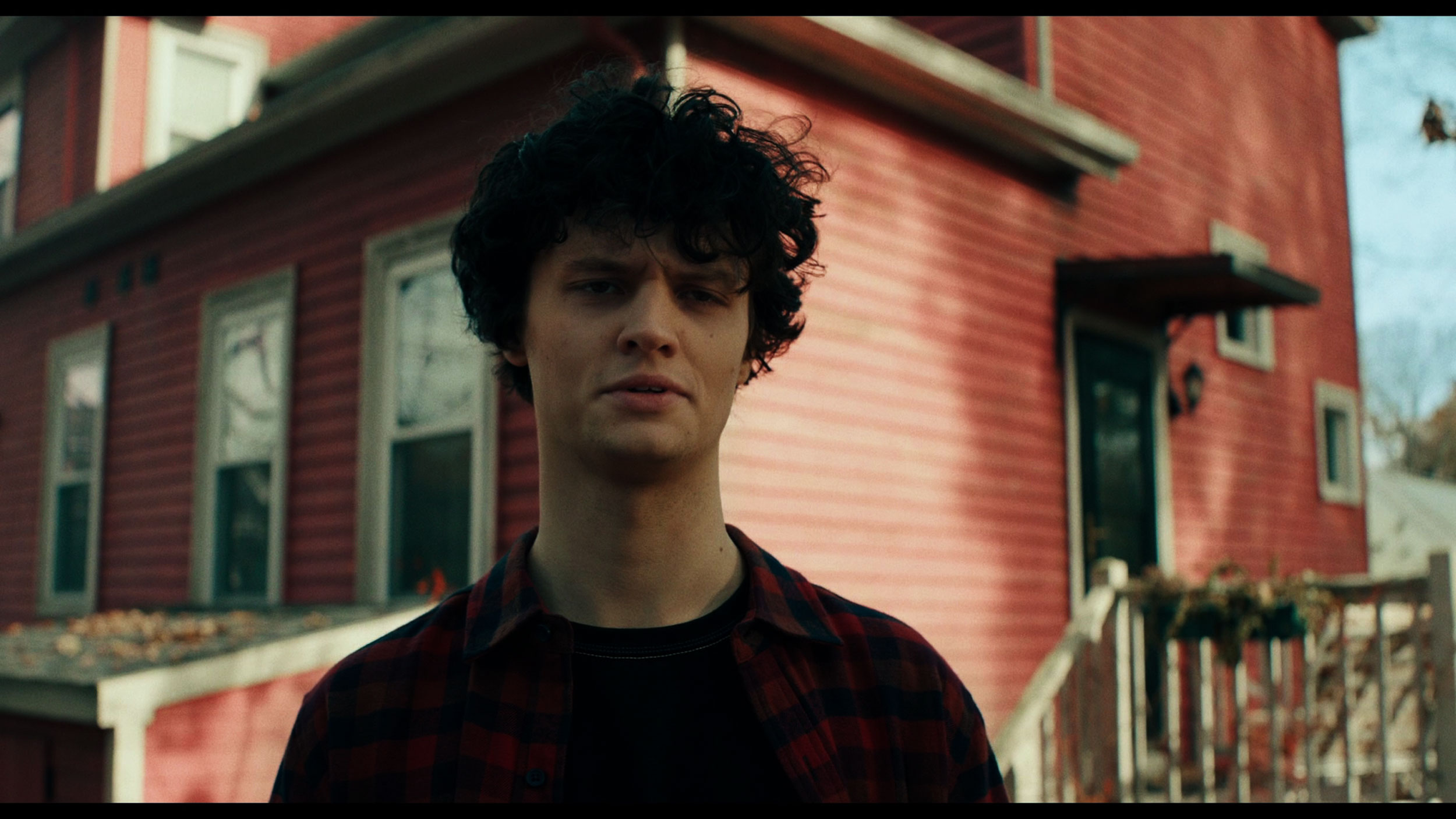- Matching (Score)
- Our verdict
- Competing TVs
- TV appearance
- Where to buy
- Contrast and black detail
- HDR effect quality
- Factory color reproduction
- Color reproduction after calibration
- Smoothness of tonal transitions
- Image scaling and smoothness of tonal transitions
- Blur and motion smoothness
- Console compatibility and gaming features
- Input lag
- Compatibility with PC
- Viewing angles
- Daytime performance
- TV features
- Apps
- Playing files from USB
- Sound
- Panel details
Haier K85F Review
K85F / K85FUX
Available screen sizes:
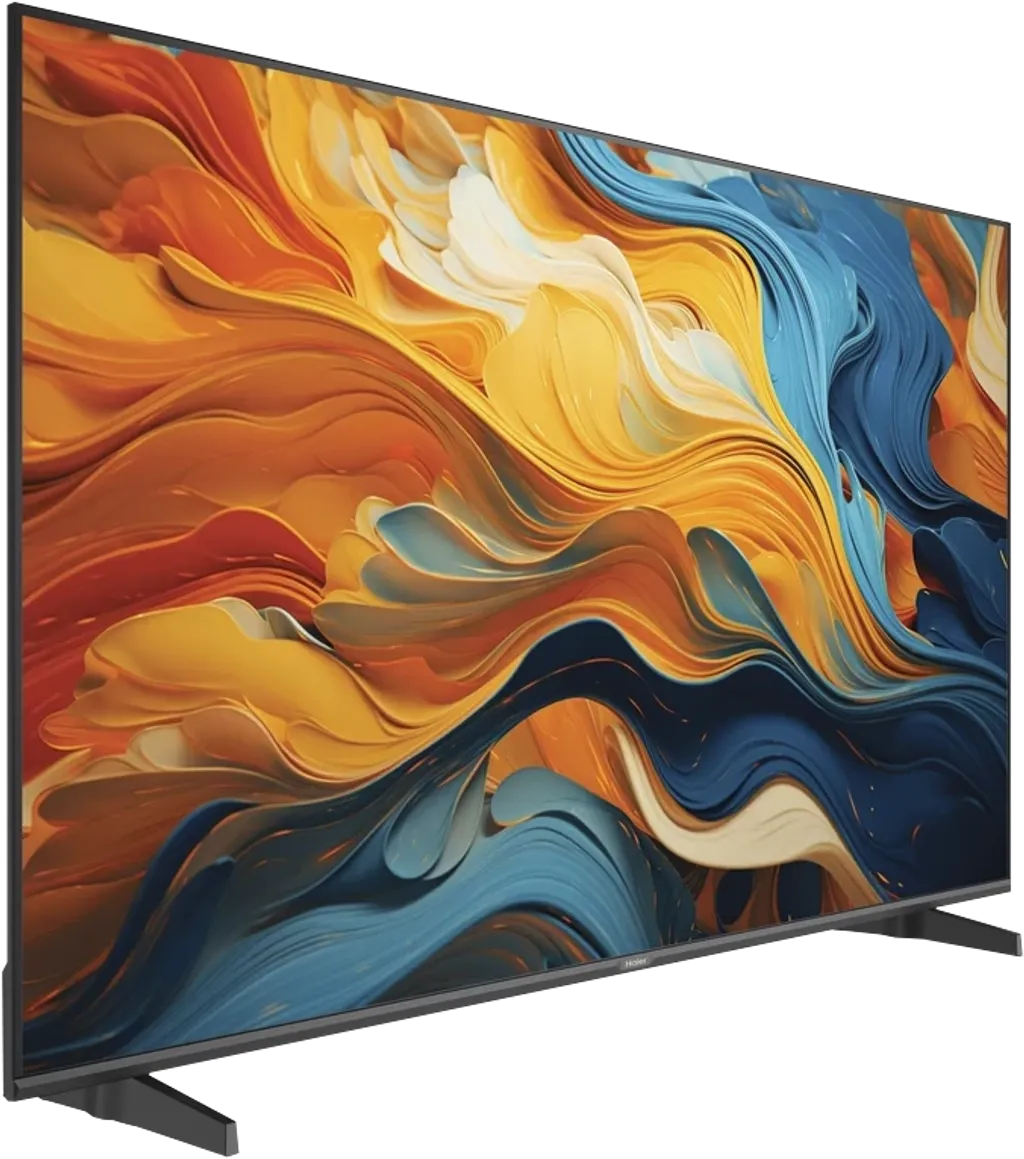
Complete the survey to find out the result
Panel type: LCD VA Refresh rate: 60Hz Brand: HAIER Resolution: 3840x2160 System: Google TV Model year: 2025
Haier, a brand mainly associated with home appliances, is boldly entering the television market, which can undoubtedly be considered a leap into the deep end. However, before we take a look at its most ambitious designs, we will focus on the K85F model – a much more accessible option. This is a fundamentally simple LCD television, driven not by "technological extravagance," but by the tried and true software of Google TV. So, let’s check if this bold debut in a completely new category can be deemed a success.
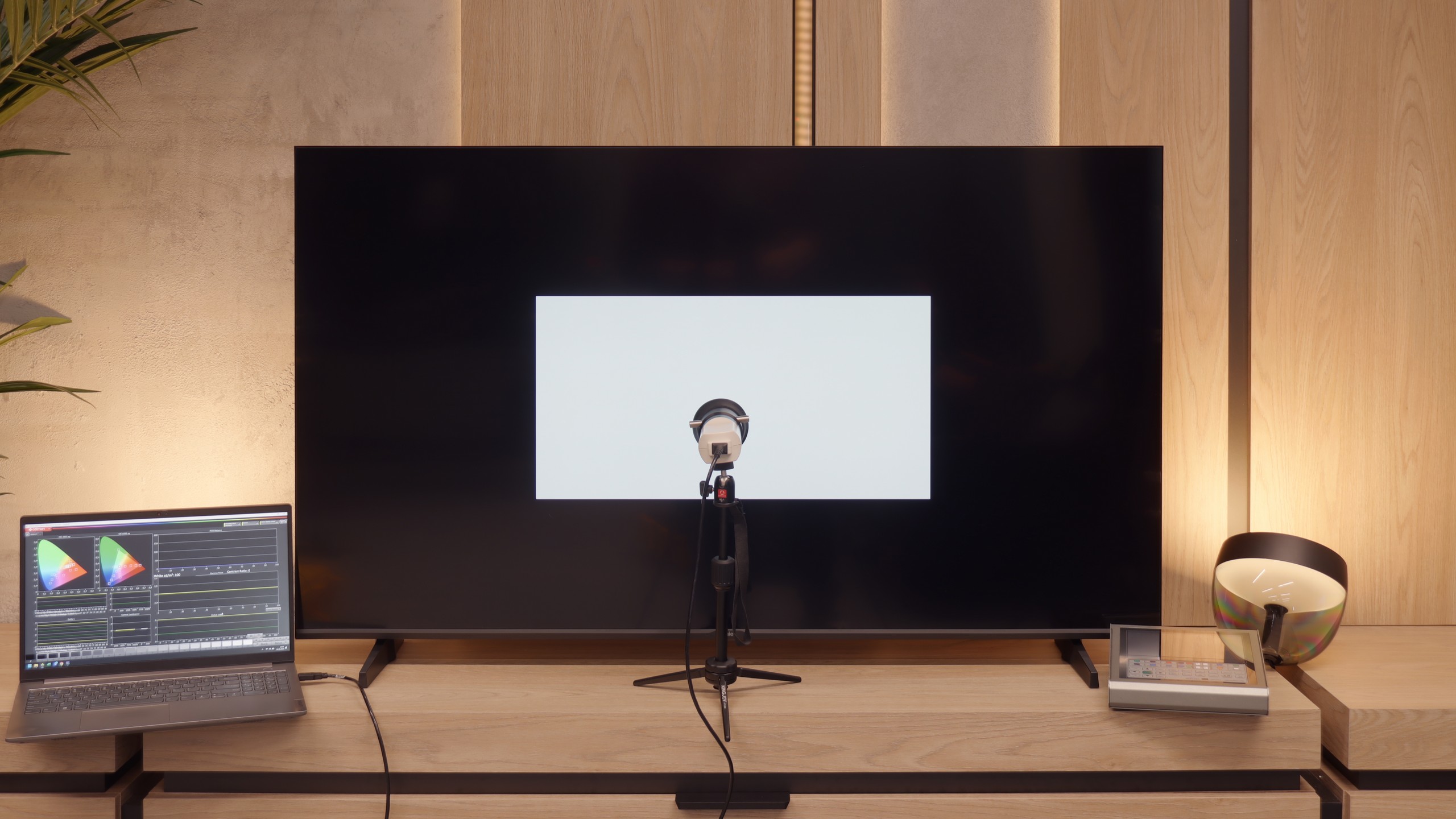
HAIER K85F - Our verdict
5.4
Overall rating
The debut of the Haier brand in the European television market with the K85F model feels quite rushed, and after thorough testing – almost unfinished. Analyzing this product leads to a fundamental conclusion: its biggest problem is not the quality of the panel used. Considering the price segment, it is simply average, with typical VA technology advantages such as high contrast and equally typical disadvantages like poor viewing angles. What truly disqualifies this model as a home entertainment centre is the glaring lack of engineering and, above all, software refinement. The list of shortcomings is long and starts with the first contact with the device. Shoddy assembly, which could have been avoided at the quality control stage, a terribly optimised and poorly translated Google TV system, or annoying issues with basic functions like pairing the remote – all contribute to an impression of a product that seems to have been launched without due diligence. Catastrophic picture quality in HDR mode, resulting not only from low brightness but also from a complete lack of smart adaptation to the signal, only adds to this disappointing picture. However, it turns out that this model has a surprising second face. Just looking at it not through the lens of a home television, but rather as a large and inexpensive display for special tasks, shifts its shortcomings to the background, bringing unexpected strengths to the forefront: a fantastically functioning media player with USB, excellent font readability from a PC, and access to a vast array of applications. In such a role – as a screen in a conference room, hotel lobby or a simple advertising player – the Haier K85F performs surprisingly well. For a typical user searching for a reliable and simply well-functioning television for the living room in 2025, however, the Haier K85F is a proposition that is extremely hard to recommend with a clear conscience. It is a product full of contradictions, which fails in too many areas in its primary, intended function as designed by the manufacturer.
Advantages
Low input lag, great for gaming
Surprisingly good file player from USB
High contrast and decent blacks (VA panel)
Good text readability in PC monitor mode
Presence of features for gamers: ALLM and VRR
Access to many apps thanks to GoogleTV
Disadvantages
Catastrophic image quality in HDR mode
Low quality of workmanship and fit of materials
Slow, glitchy, and poorly translated Google TV system
Very poor sound quality from built-in speakers
Problematic remote (and no batteries included)
Poor viewing angles
Low brightness and weak anti-reflective coating
Low colour gamut coverage
Movies and series in UHD quality
5.2
Classic TV, YouTube
5.2
Sports broadcasts (TV and apps)
4.6
Gaming on console
6.4
TV as a computer monitor
6.0
Watching in bright light
4.1
Utility functions
5.5
Apps
9.6
Sound quality
4.8
Complete the survey to find out what fits your preferences
HAIER K85F - Competing TVs in this price range
HAIER K85F - TV appearance
HDMI inputs: 4 x HDMI 2.0, 0 x HDMI 2.1 Other inputs: RCA (Chinch) Outputs: Toslink (Optical audio), eARC (HDMI), ARC (HDMI), Mini-Jack (Headphones) Network Interfaces: Wi-Fi 2.4GHz, Wi-Fi 5GHz, Ethernet (LAN) 100Mbps
Build quality: Budget
Stand type: Legs
Bezel color: Black
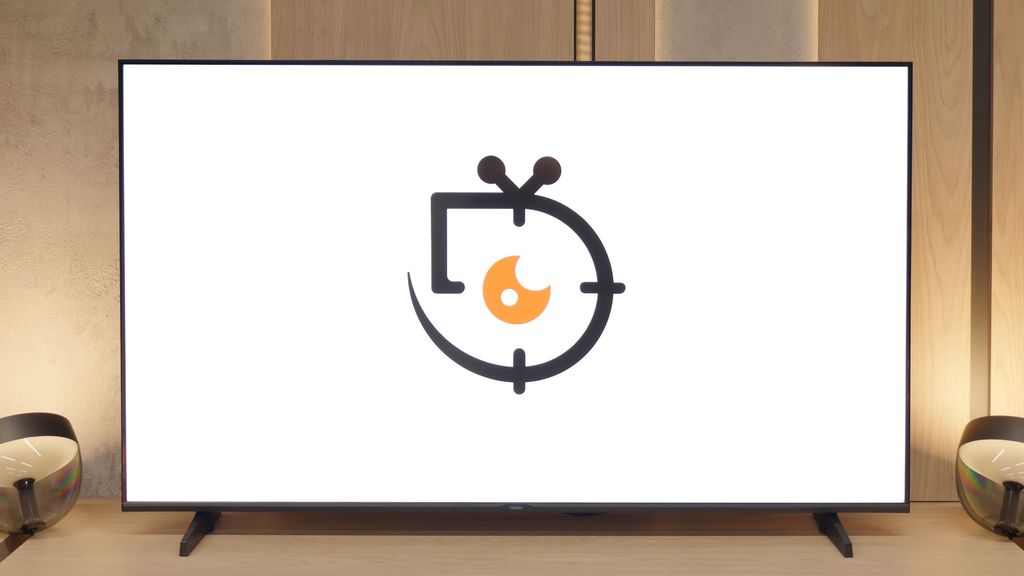
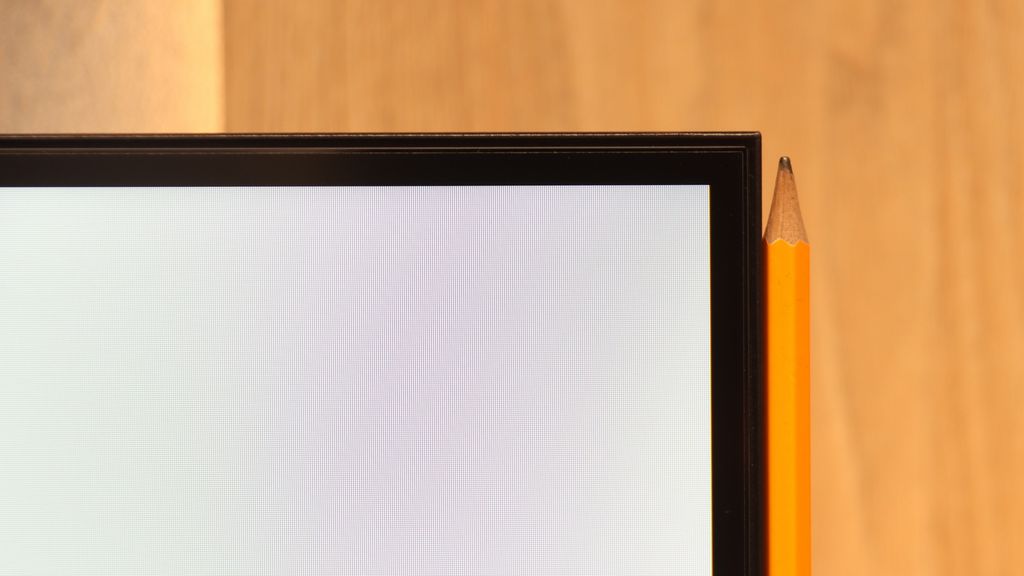
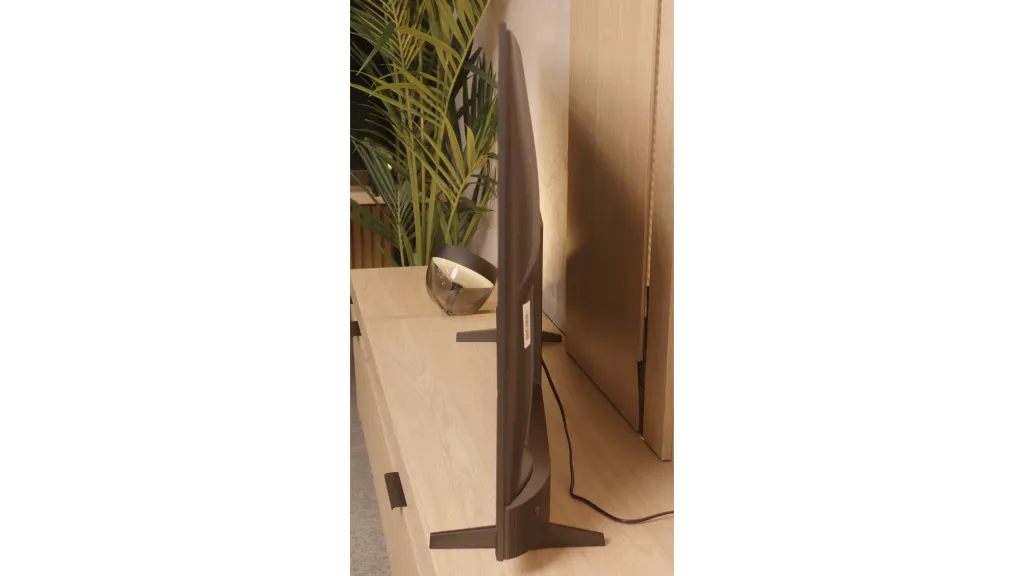
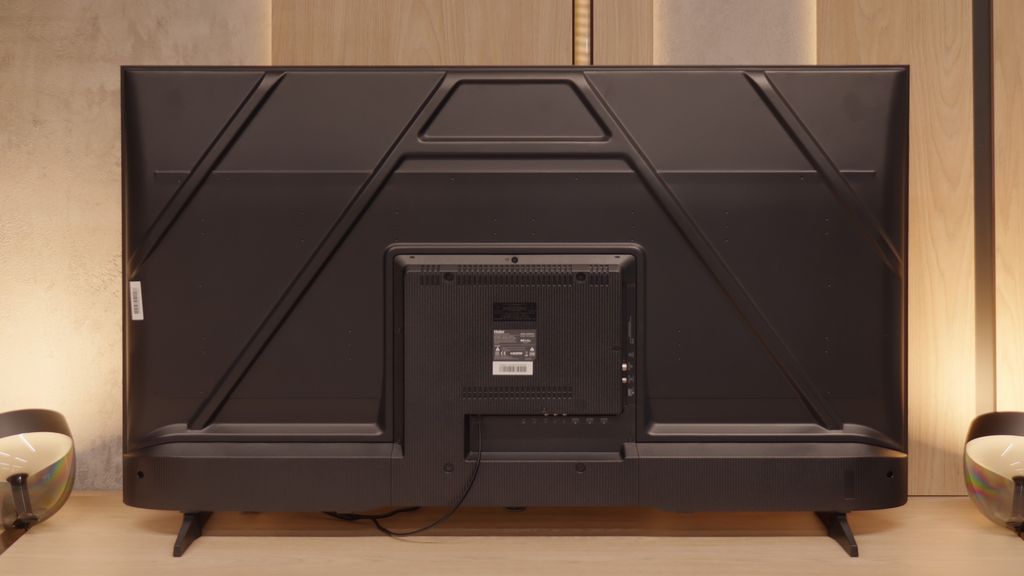
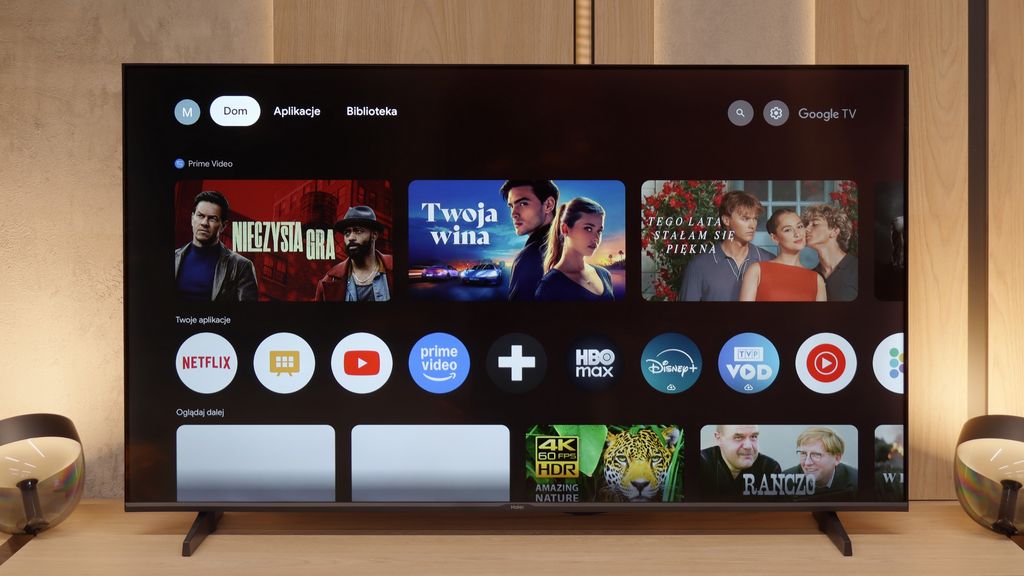
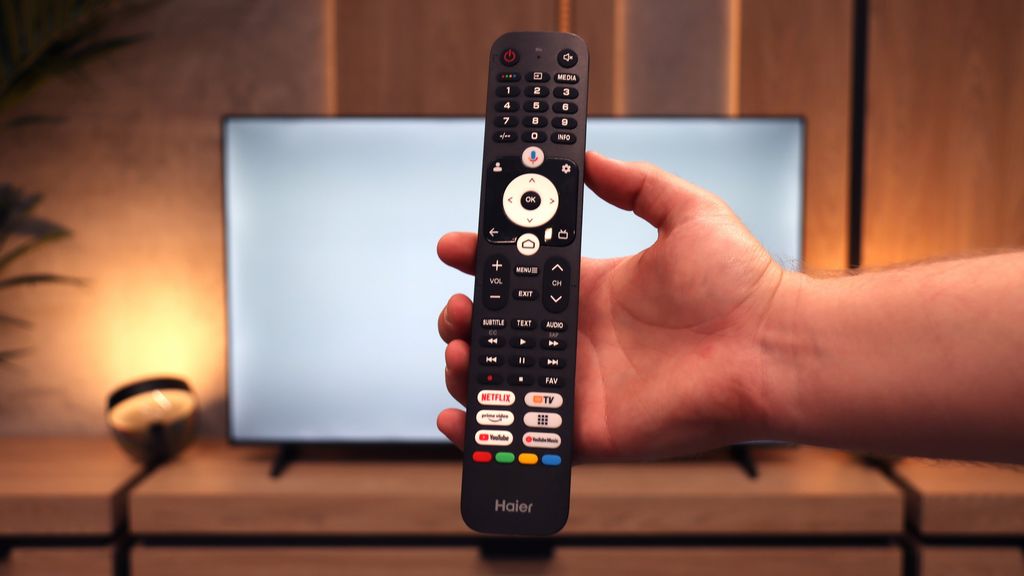
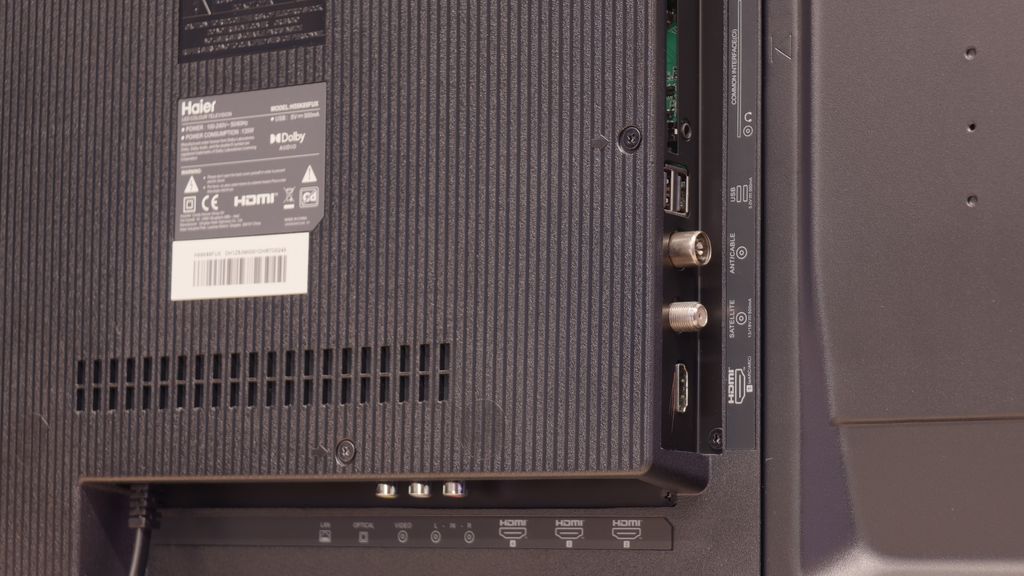
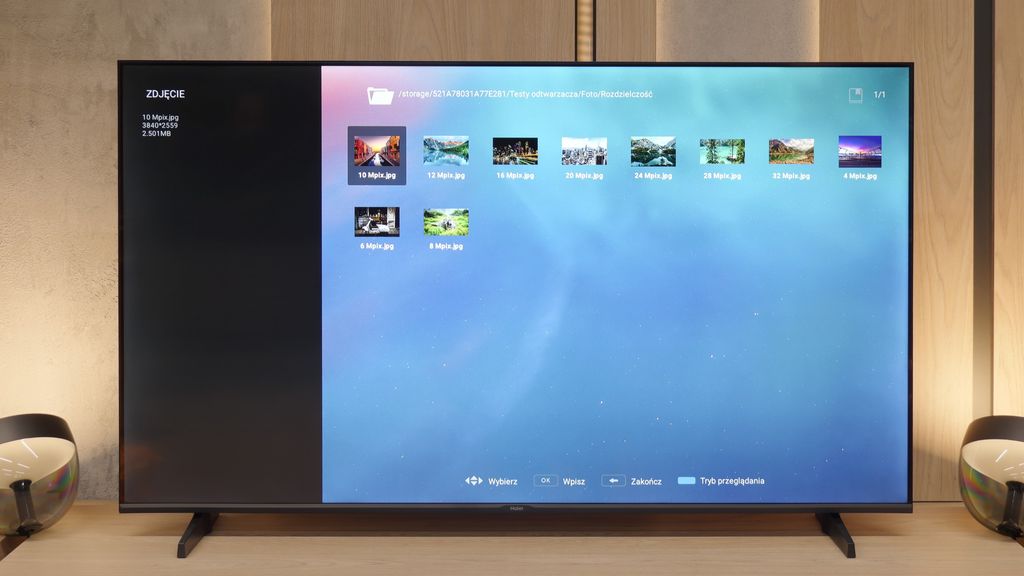
Stand: Fixed
Flat design: No
Accessories: Stand
The first thing that stands out when you take the TV out of the box is its appearance. If it seems to you that you've seen it somewhere before, you're right – Haier's designers were clearly inspired by popular models from Xiaomi's A Pro series. At first glance, it looks modern and minimalist. Unfortunately, the magic fades as soon as you handle the equipment. You can immediately feel that the plastics used are cheap, and the individual components of the casing don't always fit together perfectly. However, the real problem that highlights the production carelessness turns out to be the assembly of the feet. The manufacturer has prepared two sets of holes in the casing, which in theory should give us a choice of their arrangement. So much for theory. In practice, we find the thread only in one pair. Furthermore, the word "thread" is quite an exaggeration here. It's just a plastic socket into which the screws have to be forced in, praying that nothing breaks. Finally, there's the bezel around the screen. While it's quite thin, its finish is so careless that one might think: "It looks like it was worked on by a blacksmith with a hammer." And it's hard to disagree with that thought.
Buy at the best price
Select size:
HAIER K85F - Contrast and black detail
5.6/10
Local dimming function: No

Result
3,550:1

Result
5,200:1

Result
5,350:1

Result
5,400:1

Result
3,500:1
Visibility of details in the lights:
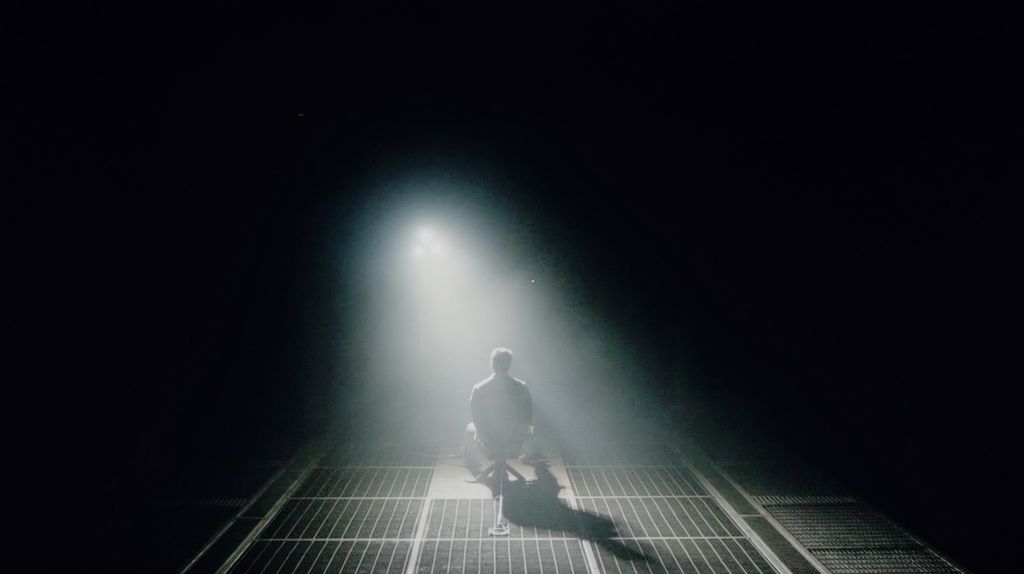
Alright, but let's get to the meat of it, that is, how the Haier K85F handles black and contrast. The key information is that the television uses a VA panel, which is crucial for image quality in dark scenes. Thanks to this, the contrast is really solid – our measurements indicated values around 5000:1, which is much better than popular IPS panels.
However, it is important to remember that we're discussing budget equipment. So, we shouldn't expect any advanced technologies like local dimming. The backlighting operates across the entire screen surface at all times. How did it look during viewing? We took the film "Oblivion" with its cosmic landscapes for a test, and we also checked classic black bars in other productions. The effect was quite decent. The black had good depth, but it wasn't perfectly inky – a slight blue glow could be noticed, indicating that the panel's backlighting was still active.
Halo effect and black detail visibility:
HAIER K85F - HDR effect quality
3.4/10
Supported formats: HDR10 Color gamut coverage: DCI P3: 81.8%, Bt.2020: 61.4%
Luminance measurements in HDR:

Result
217 nit

Result
212 nit

Result
278 nit

Result
250 nit

Result
273 nit
Let’s now move on to one of the hottest topics in the world of televisions, which is the quality of HDR performance. In the case of the Haier K85F model, we unfortunately have to make it clear: if you’re looking for equipment to watch content in a wide dynamic range, you should steer clear of this model. The main issue is its very low peak brightness, which during our tests barely reached 250 nits. To give you a better idea of what that means – this level is fine for watching standard SDR content, but it’s absolutely insufficient to show any real benefits of HDR. The image simply doesn’t have the "power" to generate bright, striking highlights. All of our measurements and tests on specialised test patterns confirmed this. As if that wasn’t enough, the television also struggles with colour reproduction. In this budget build, there are no technologies that broaden the colour gamut, such as quantum dot layers (marketed as "QLED"). As a result, the coverage of the DCI-P3 colour space, which is crucial for HDR content, is only around 80%. In practice, this means that the image will not only be dark but also devoid of the vibrant, saturated colours that the director wanted to show us.
Scene from the movie “Pan” (about 2800 nits)

Scene from the movie “Billy Lynn” (about 1100 nits)

Well, low brightness is not the end of the world. We've had experiences testing televisions that didn't look impressive on paper, yet could intelligently process HDR signals. Thanks to advanced algorithms, they could "trick" the system into displaying a picture full of depth and detail in bright areas, even on a relatively dark screen, preserving the director's vision. This is known as tone mapping, or image adaptation. Unfortunately, we don’t have good news for you on that front. The Haier K85F seems completely devoid of this capability. We get the impression that the television doesn’t respond at all to so-called HDR metadata, which are instructions embedded in the signal that tell it how to display a given scene. The result is dismal and easy to predict: most HDR content is simply overly blown out. Bright elements of the image, such as the sky, lights, or explosions, merge into one large white blob, devoid of any details. Quite frankly, the picture looks terrible. Therefore, for this television, our advice is simple and firm: we don't recommend using HDR material at all. You'll get a better effect watching standard SDR content.
HDR luminance chart:
HDR luminance
The next nail in the coffin, as far as HDR quality goes, is the lack of support for any format with dynamic metadata. What does this mean in practice? The standard HDR10, which this TV supports, sends a single, fixed set of brightness information to the screen for the entire movie. In contrast, formats like Dolby Vision or HDR10+ provide these instructions scene by scene, or even frame by frame. This typically acts as a sort of "lifeline" for lower-end TVs. Even if the TV itself cannot intelligently map tones and adjust the picture, content recorded in a dynamic standard effectively guides it, suggesting how to display bright and dark parts of the image at any given moment. Unfortunately, with the Haier K85F, we won’t find such assistance. The manufacturer has not equipped it with either Dolby Vision or HDR10+. This means we are left solely with its own very poor image processing capabilities. This ultimately confirms our earlier thesis: this TV and HDR technology simply do not go hand in hand.
Static HDR10

Factory color reproduction
3.8/10
Alright, how does the television handle colours straight out of the box, without any intervention from our side? The Haier K85F offers a whole range of picture modes, such as Dynamic or Eco, but for anyone wanting to watch films according to the creators' intentions, there's essentially only one that matters: Film mode. This is where we focused our tests, and unfortunately, its name has little to do with reality. The picture on factory settings is very far from what we could call cinematic fidelity and requires many adjustments. Let's start with the white balance, which has a clear deficiency of red colour. In practice, this means the entire image has a cool, bluish tint. Even worse is the issue of brightness management, that is, the gamma curves (for SDR) and EOTF (for HDR). Their graph resembles a true rollercoaster, which terribly impacts the viewing experience. This results in unnatural dimming of SDR content, causing details in the shadows to be lost, and in the case of HDR – an excessive brightening that further exacerbates the problem of clipping. Such a combination, which consists of too cool white combined with chaotic brightness and too much blue colour saturation, leads to enormous errors in colour reproduction. Our measurements on a specialist ColourChecker chart showed errors (Delta E) regularly reaching and exceeding values of 8-9. To put it simply: errors above the threshold of 3 are easily noticeable to the naked eye, so such a result means that the colours on the screen are simply heavily distorted.
Color reproduction after calibration
6.2/10
No good, but can anything be done about this picture? Is professional calibration able to save the situation? The answer is both yes and no. It needs to be said clearly that there are certain things we cannot overcome. The limitations of the construction itself, namely a poor panel and its narrow colour coverage, mean that you can forget about a sensible HDR effect – we won't be pulling the wool over your eyes on that. The biggest beneficiary of our adjustments is undoubtedly the SDR mode, and it is for watching such content, after calibration, that this television starts to make sense. We managed to tame the white balance in our own way. Although the television only offers basic, 2-point adjustment (rather than precise, 20-point), it's not perfect, but we successfully eliminated that unpleasant, cold "chill" in the picture. Above all, though, we noted a huge improvement in brightness management. The gamma curve, which previously resembled a rollercoaster, looks like an almost perfectly straight line after calibration. This is a sign that the television can finally display an image without artificially dimming or brightening it. The conclusion is simple: even with such a cheap television, professional setting correction can achieve a great deal and extract the maximum potential from it.
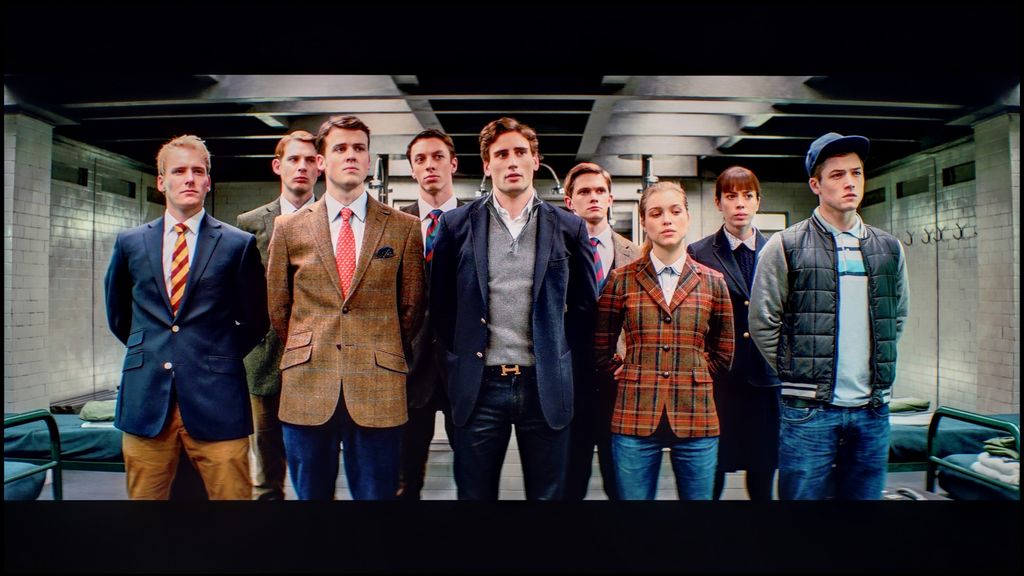

HAIER K85F - Smoothness of tonal transitions
7.6/10
It's time to address an issue that is often overlooked by many but can be quite irritating to the discerning (and not just discerning) eye. We're talking about the smoothness of tonal transitions, or how seamlessly the screen displays transitions between very similar shades of one colour – for instance, on a clear blue sky. We have to admit that in this category, the Haier K85F, considering its price, performs quite decently. In bright scenes, such as the aforementioned sky or expansive landscapes in the film "The Martian," there are no stark, contrasting bands. Yes, if we scrutinise closely, we can spot minimal imperfections, but generally, the effect is more than satisfactory. However, the situation changes when darker scenes make an appearance on the screen, such as gloomy corridors in games or nighttime landscapes. Here, banding, or the effect of posterization, becomes much more evident. Transitions in shadows and greys are no longer as smooth and can become quite bothersome to a more sensitive eye. It's not a level that would completely disqualify the television, but it is clear that this is an area where costs were saved.
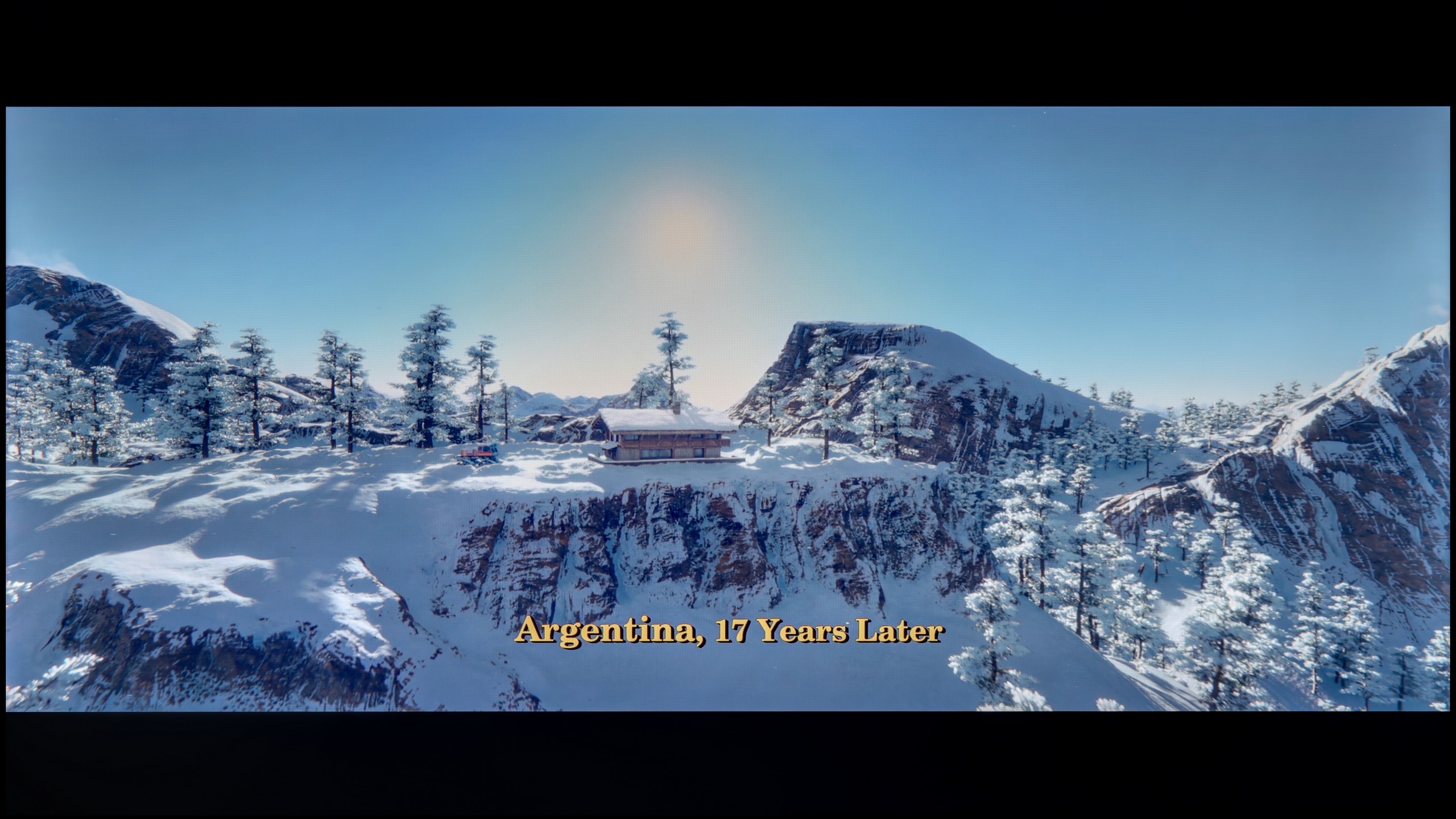


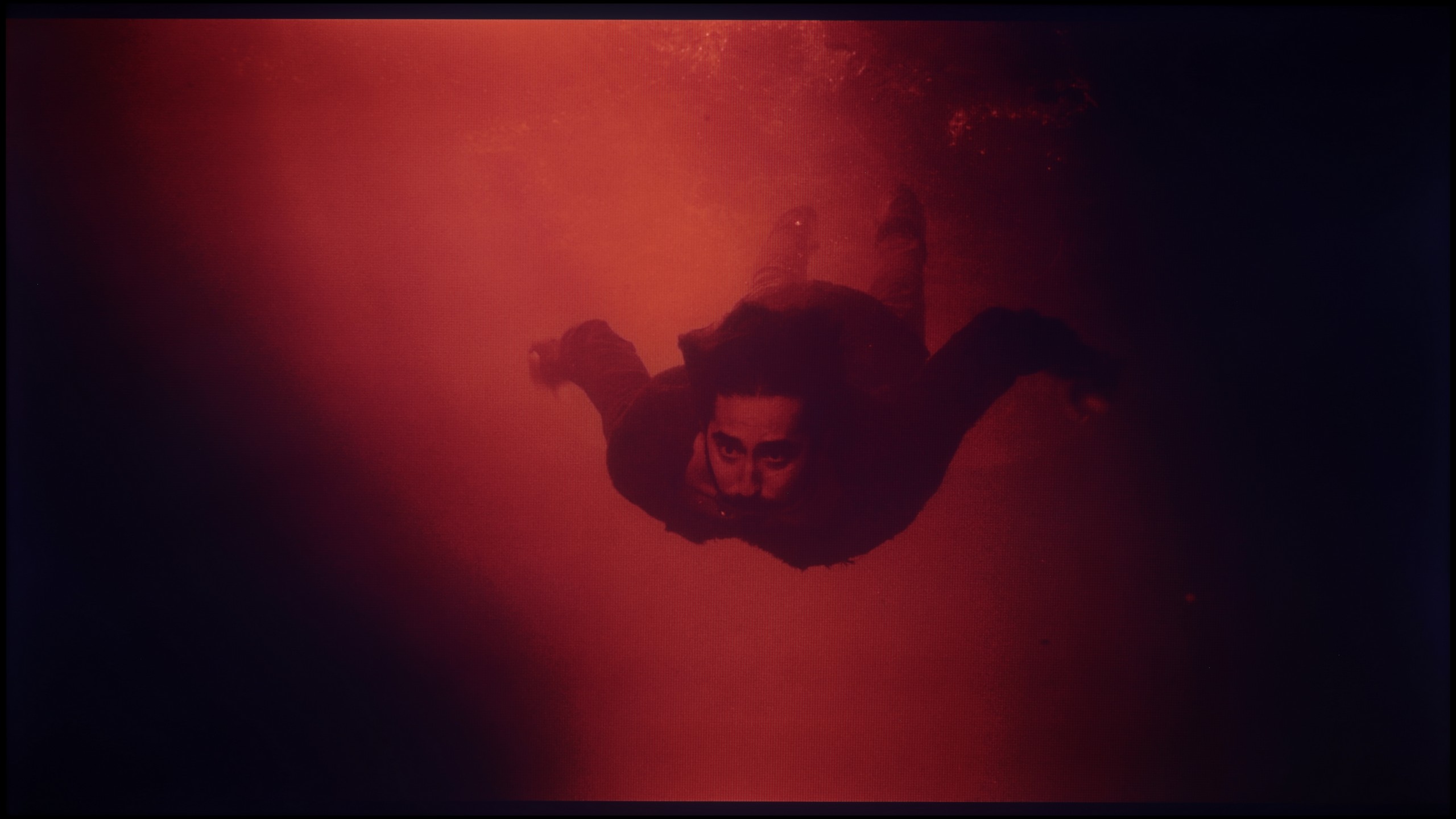




Image scaling and smoothness of tonal transitions
4/10
Smooth transition function
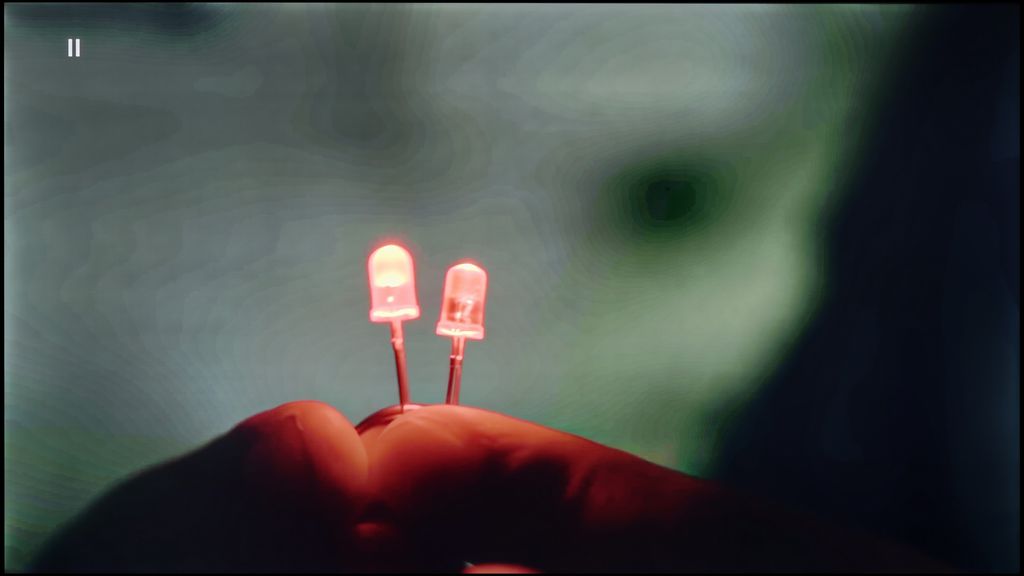
Image without overscan on the SD signal

Let’s move on to digital processing and image scaling, specifically how the Haier K85F handles lower resolution signals, such as from regular television. Right off the bat, we encounter an incredibly annoying and completely incomprehensible issue – the overscan is enabled by default. This means the television artificially enlarges the image, cutting off its edges on every source, even 1080p. To see the full frame, you have to dig into the screen settings each time and manually switch the format to "stretch to 16:9." It's a minor detail, but devilishly frustrating. The scaling of content to 4K resolution can be described in one word: acceptable. And that's about it. The image processor doesn't strip detail from the image, nor does it generate jagged edges or other artifacts. It simply does its job, without any bells and whistles. It’s alright, but nothing more. The most significant and noticeable shortcoming in the digital processing section is, however, the absence of a tone transition smoothing feature. This is an algorithm that could significantly reduce the annoying banding effect we mentioned earlier. Unfortunately, the manufacturer did not foresee such a solution, condemning us to watch the imperfections of the panel and low-quality material in all their glory.
HAIER K85F - Blur and motion smoothness
4.5/10
Maximum refresh rate of the panel: 60Hz
Film motion smoothing option: Yes
Blur reduction option: No
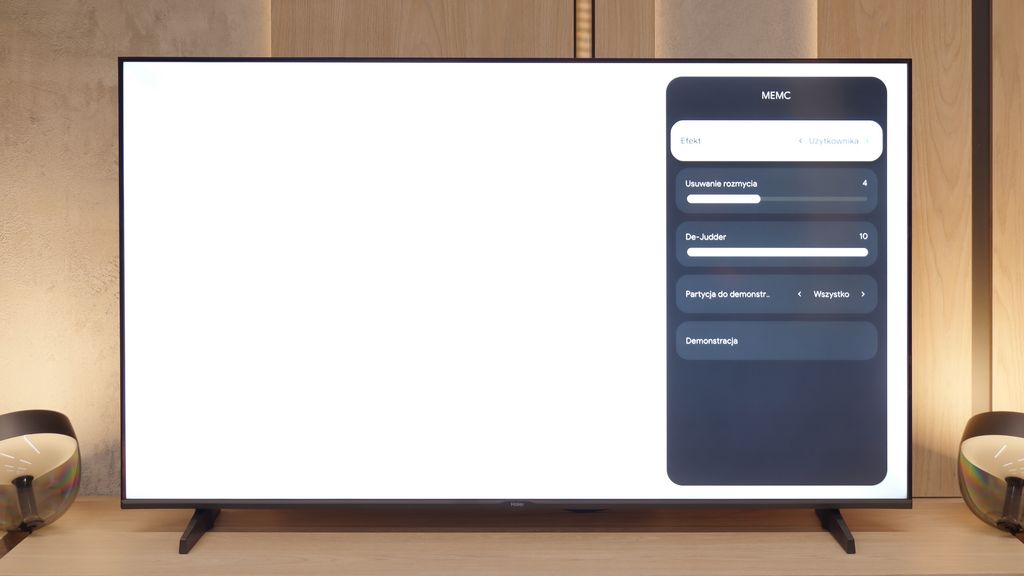
The panel in the K85F model operates at a native refresh rate of 60 Hz, which sets certain expectations for image smoothness right from the start. However, we must admit that we were very positively surprised when we found two separate motion control sliders in the settings menu: one labelled "Motion Blur Reduction" and the other "De-Judder." Such generosity in this price segment is an absolute rarity, as manufacturers usually offer at most one shared option. Unfortunately, our enthusiasm faded as quickly as it appeared. It soon became clear why Haier was so "generous" – the slider responsible for reducing motion blur is simply a decoy. Sliding it makes absolutely no visible difference on the screen, so only one of the two options works.
Blur (native resolution, maximum refresh rate):
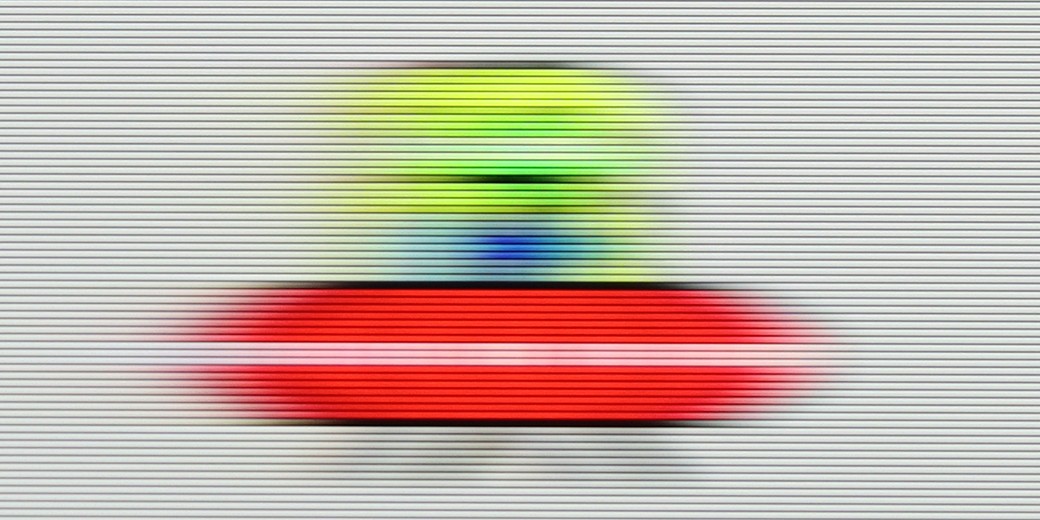
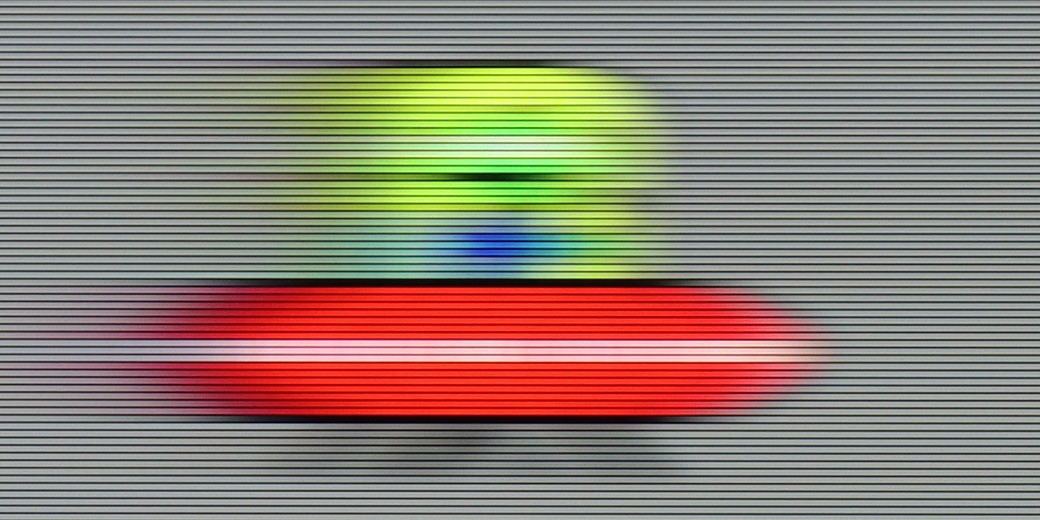
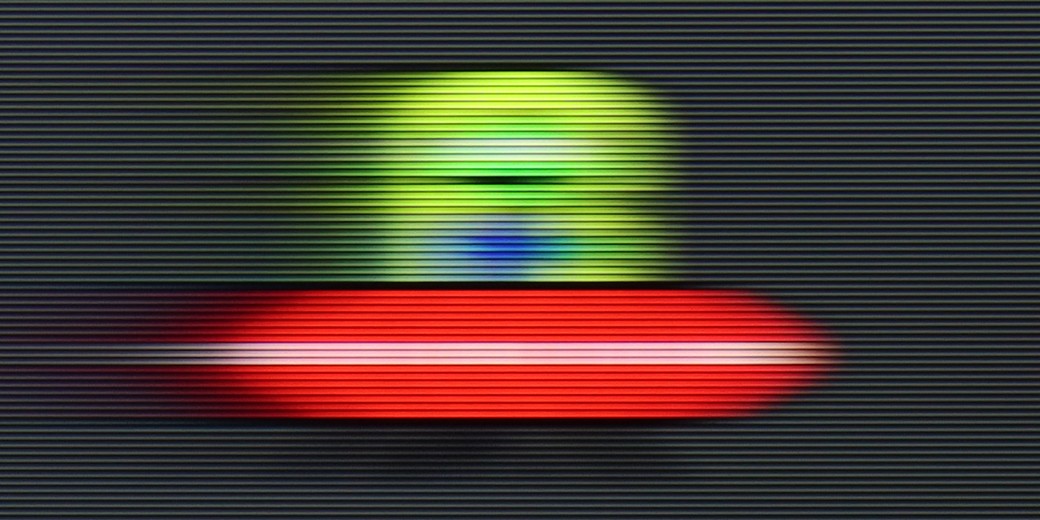
And what does fluidity look like in practice? Due to the 60Hz panel, the overall sharpness of moving objects is at an average level, typical for this class of equipment. To make matters worse, the VA panel used here has its drawbacks, the biggest of which is noticeable ghosting, which becomes particularly bothersome in darker scenes when bright elements move against a dark background. The image can then leave visible afterimages behind.
HAIER K85F - Console compatibility and gaming features
4/10
ALLM: Yes
VRR: Yes
VRR range: 48 - 60Hz
Dolby Vision Game Mode: No
Correct implementation of HGIG: No
1080p@120Hz: No
1440p@120Hz: No
4K@120Hz: No
Game bar: No
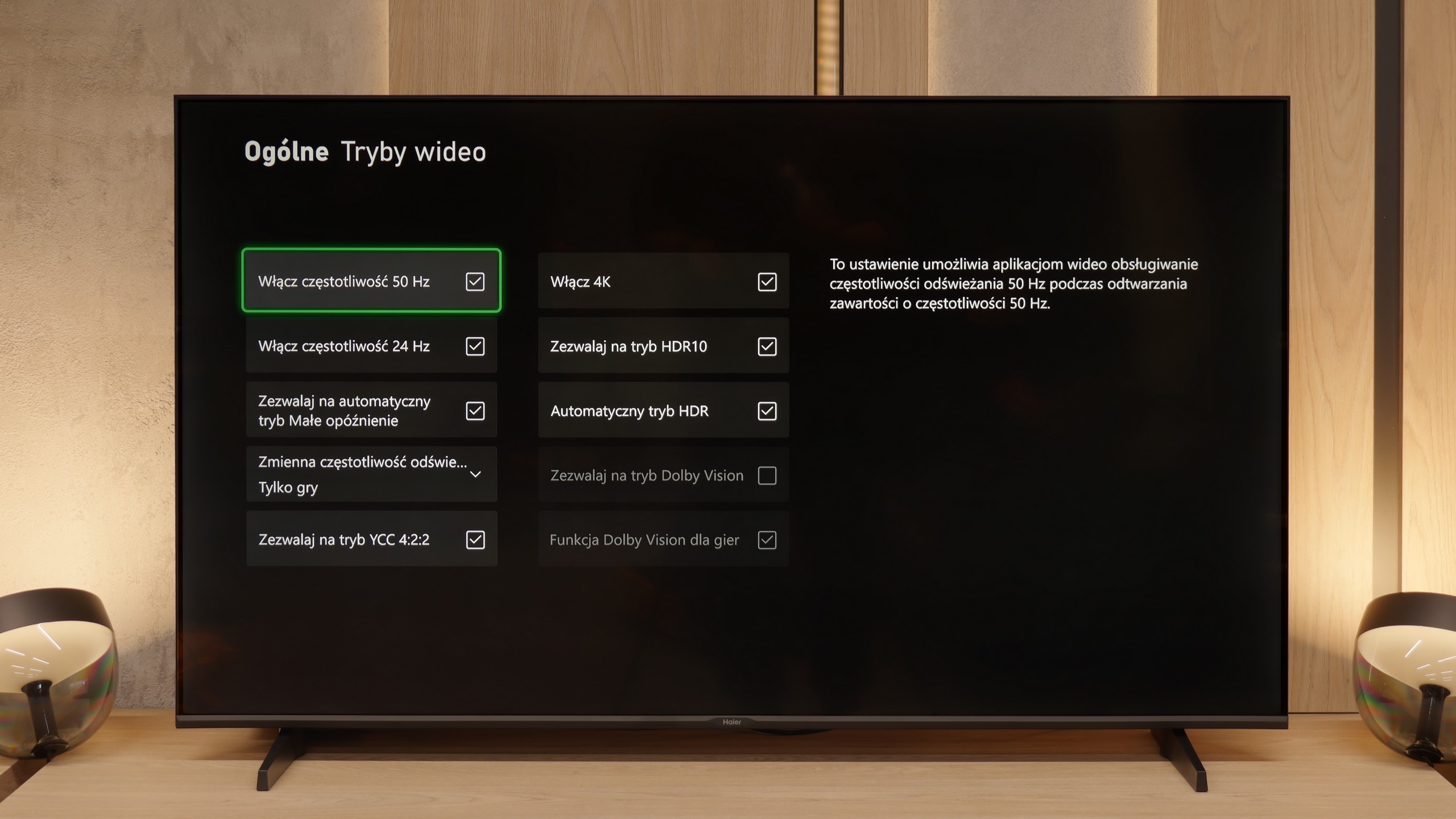
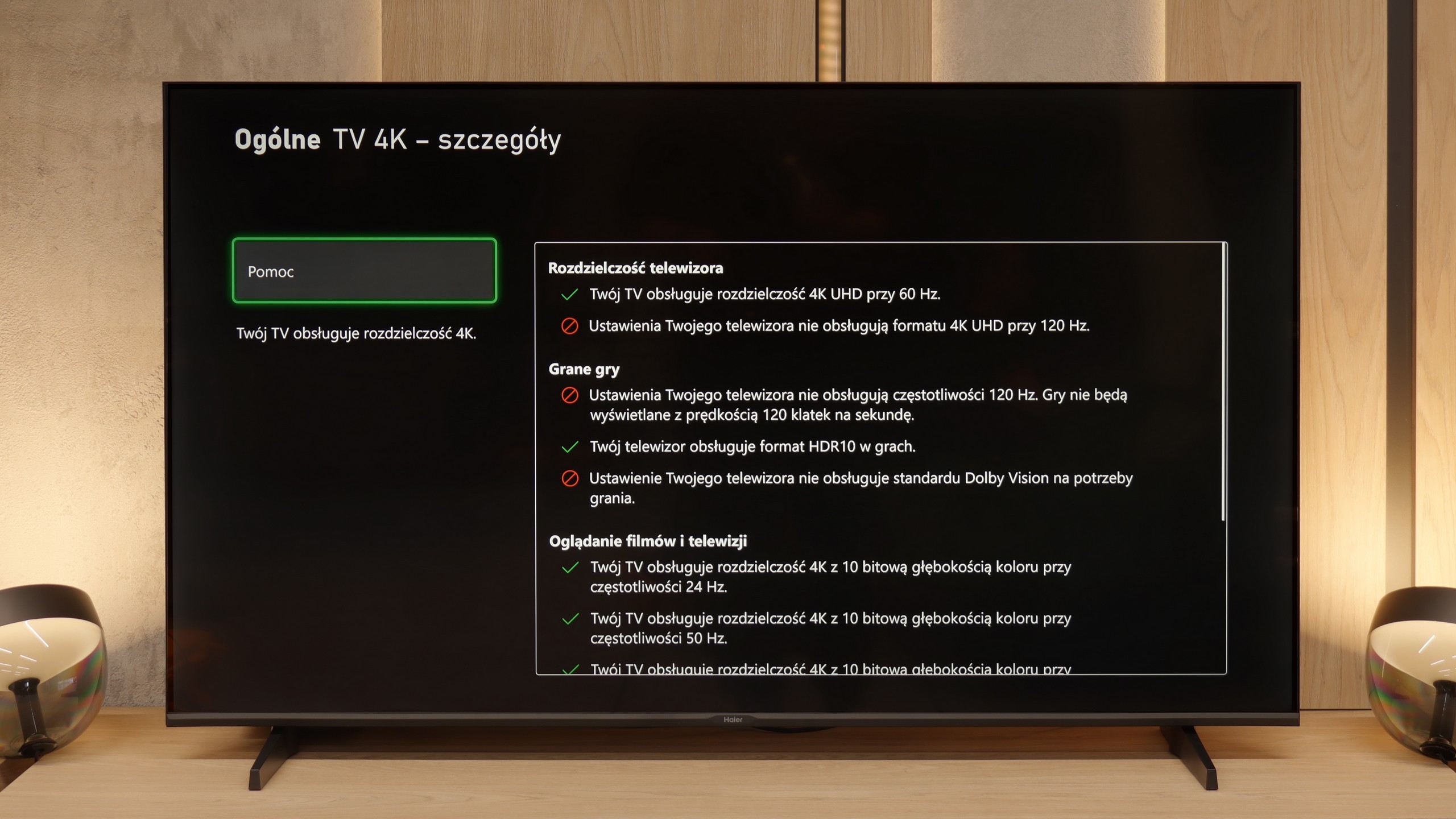
Let’s move on to the features for gamers, although we must point out straight away that this is more of a proposal for the "occasional" ones. The manufacturer does boast in the specifications about having HDMI 2.1 ports, which looks impressive on paper, but in reality, it’s largely a marketing ploy. What good is a modern port when the heart of the television is a panel with a refresh rate of 60 Hz? It physically cannot display a signal at 120 frames per second, even at lower resolutions, which takes away HDMI 2.1’s key advantage. What a shame. (That’s why in our tests we note this as HDMI 2.0 ports). Another odd issue is the TV's response to an attempt to calibrate HDR from the console. Changes to brightness settings result in very unnatural image behaviour, which could suggest incorrect implementation of the HGiG standard. To be honest, one shouldn’t worry too much about this, as we have repeatedly mentioned, we simply do not recommend using any HDR content on this screen. However, to counterbalance the negatives, the Haier K85F does have two big and unexpected advantages. The first is the presence of ALLM, or automatic game mode, which switches the TV to low latency mode as soon as it detects a connected console. The second, even bigger surprise, is support for VRR, or variable refresh rate. While it operates within a very modest range of 48-60 Hz, its mere presence is commendable. Thanks to this, the image in games can “tear” less, which realistically improves the gaming experience.
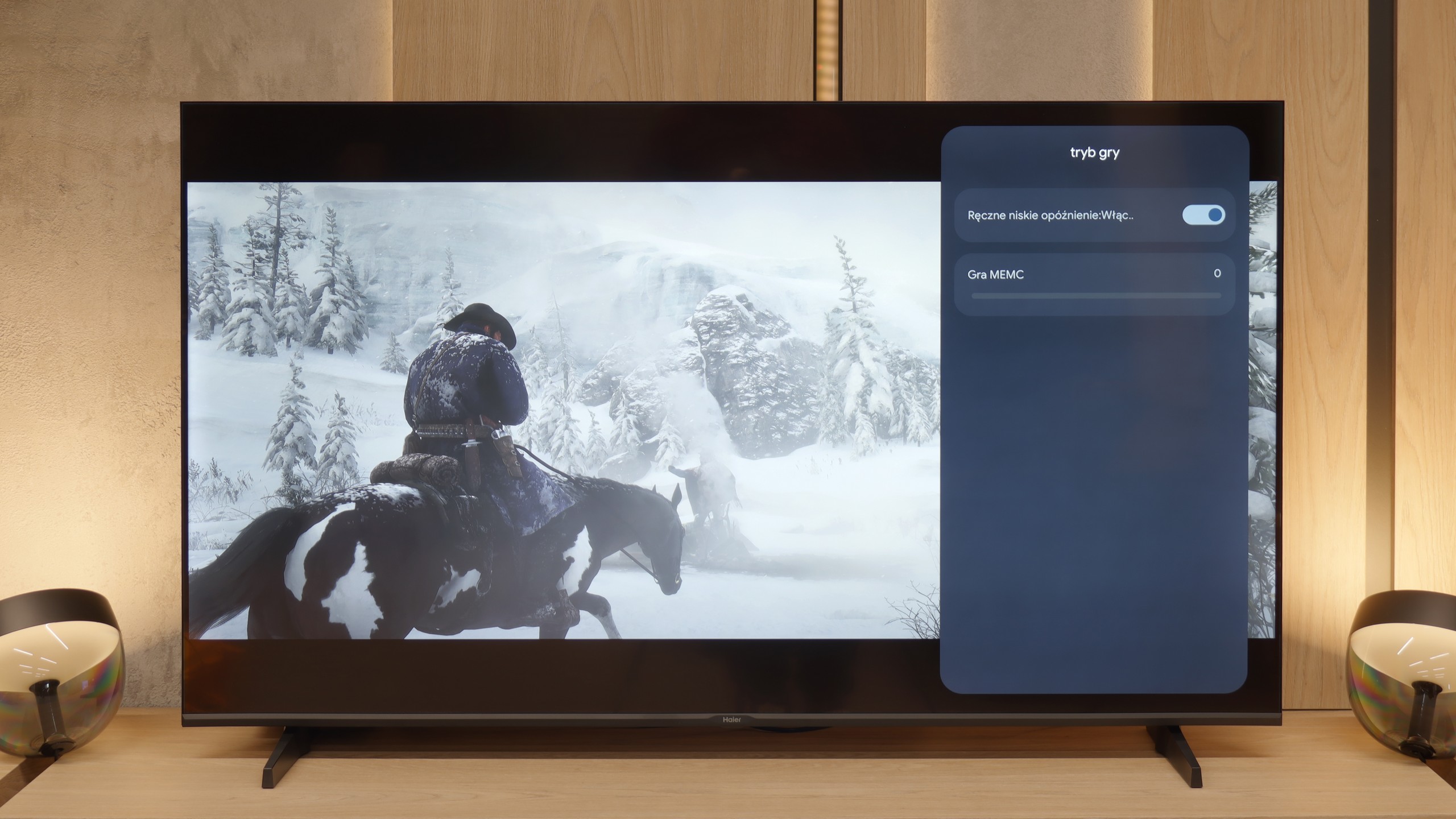
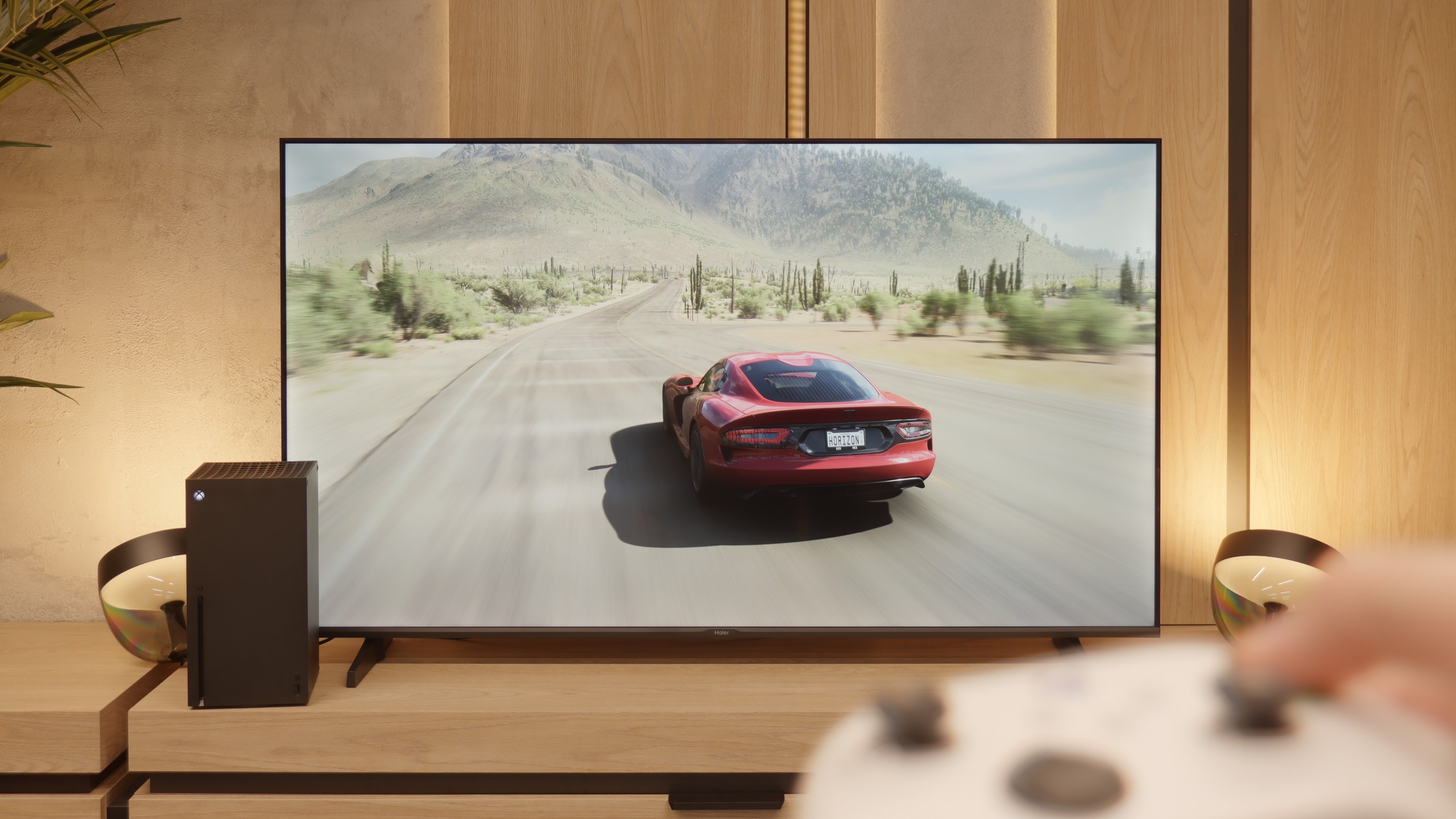

HAIER K85F - Input lag
10/10
We must give credit where it's due – there is one parameter where this television absolutely shines and puts to shame many more expensive models. We're talking about input lag, or signal delay. Our measurements showed a remarkably low result of just 13 ms. This is a huge plus that makes gaming control lightning-fast and incredibly responsive. In this regard, the K85F performs excellently.
| SDR | HDR | Dolby Vision |
|---|---|---|
| 1080p60: 13 ms | 2160p60: 13 ms | 2160p60 DV: 13 ms |
| 2160p60: 13 ms |

HAIER K85F - Compatibility with PC
6/10
Chroma 444 (maximum resolution and refresh rate): Yes
Font clarity: Very Good
Readability of dark text and shapes: Very Good
Input lag in PC mode (4K, maximum refresh rate): 13ms
Matrix subpixel arrangement: BGR
Max refresh rate: 60Hz
G-Sync: No
And what if we tried using this Haier as a computer monitor? Here, what was a big surprise for us was that the television performs exceptionally well. For office work, it’s perfect. All thanks to the fact that it correctly handles the so-called 4:4:4 chroma sampling. To put it simply: every little letter on the screen is sharp, without annoying coloured edges or blurriness. Sure, let’s be frank – this is not equipment for PC gamers. 60 Hz is too low for them. But if you just need a big screen for text work, browsing the internet, coding or displaying presentations, the K85F excels in this role. This is one of its strongest and, let’s face it, most unexpected applications.
HAIER K85F - Viewing angles
2.8/10
Brightness drop at an angle of 45 degrees: 67%
At nearly the very end of the evaluation of the panel itself, we left out the viewing angles, which unfortunately are one of its biggest weaknesses. It must be honestly admitted that this is not surprising – it is simply a natural and commonly known feature of VA-type panels. In the unit we tested, interestingly, the brightness of the image did not drop drastically when we moved away from the centre of the screen. However, the real problem lies with the colours, which instantly begin to fade. A slight change in position on the couch is enough for the hues to lose their saturation and become washed out. In this regard, the Haier K85F presents a very average, typical level for this technology.
HAIER K85F - Daytime performance
4.1/10
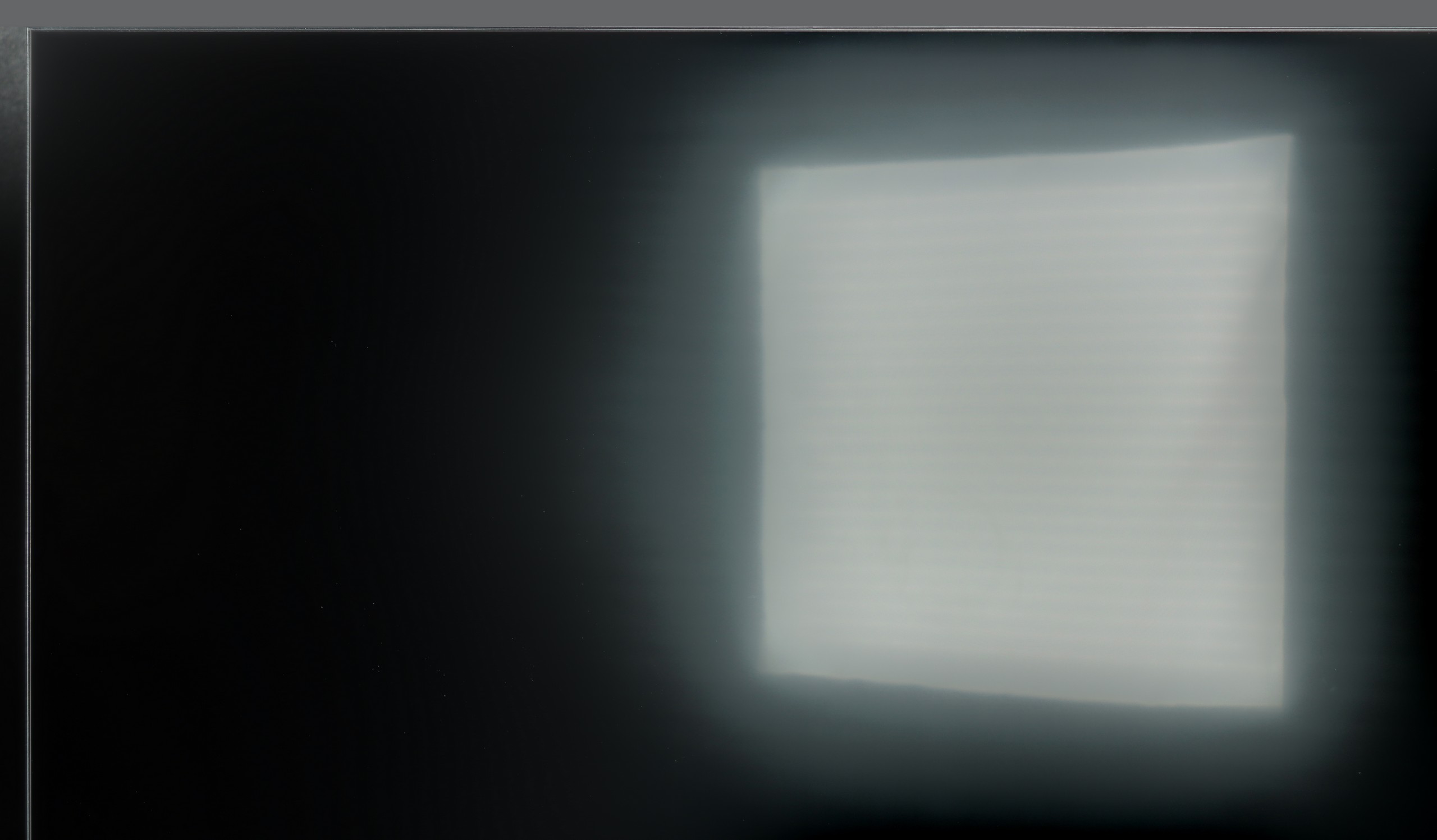
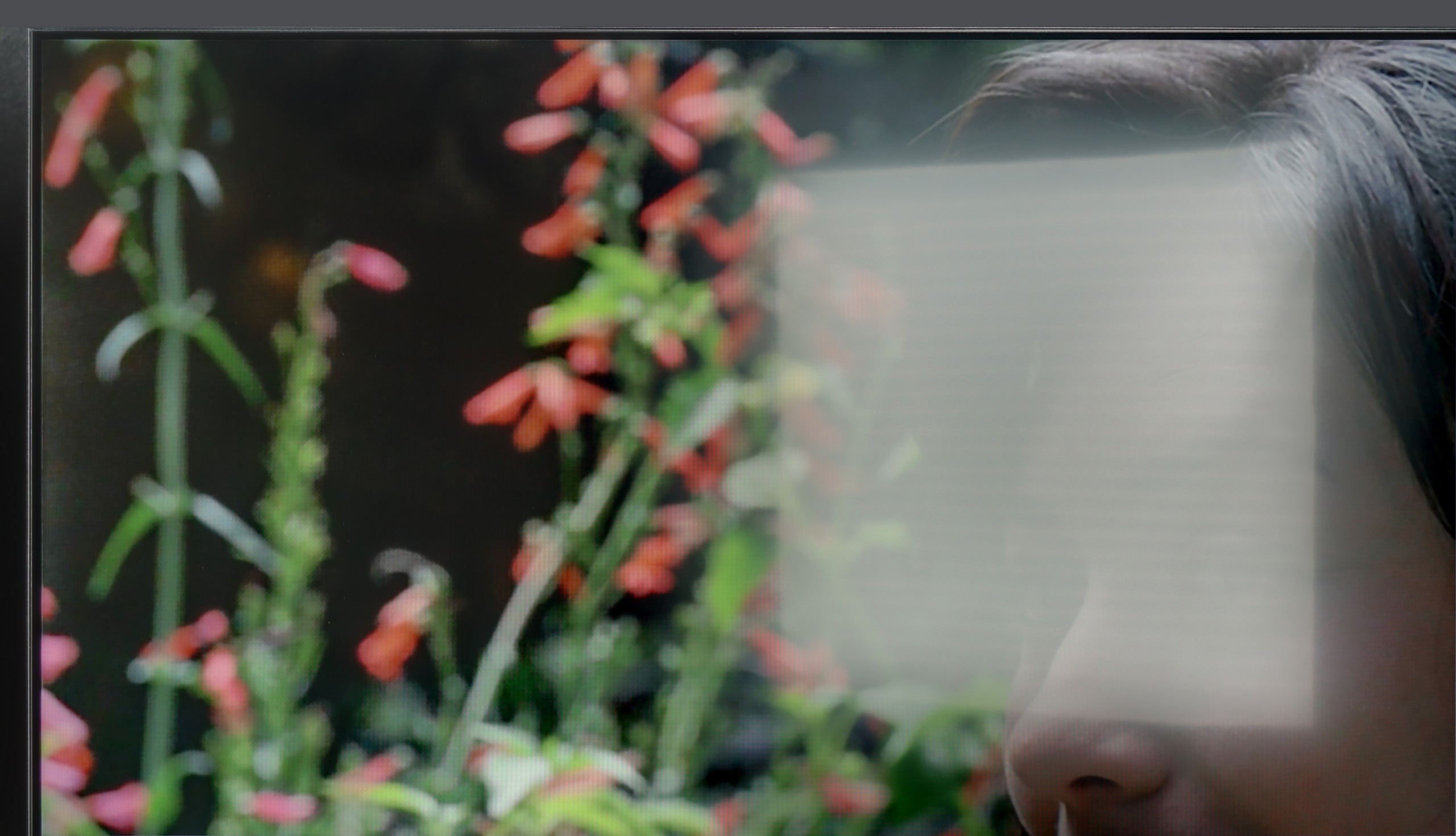
Panel finish: Satin
Reflection suppression: Average
Black levels during daytime: Good
And how does the television perform in confrontation with daylight, for example in a brightly lit living room? Unfortunately, we don't have good news here. As we have established, it is a television with relatively low brightness, which becomes a serious drawback when faced with sunlight. The situation is further worsened by the screen coating used. Instead of effectively suppressing reflections, its satin structure tends to unfavourably scatter them. In practice, this means that the reflection of a window or lamp turns into a large, blurred, milky haze that degrades contrast and effectively hinders viewing. The conclusion is therefore clear: if the television is to be placed in a bright room, the K85F model will not be a good choice.
Panel brightness
Average luminance SDR
Haier K85F: 276 cd/m2
HAIER K85F - TV features
5.5/10
System: Google TV
System performance: Poor
- HDMI inputs: 4 x HDMI 2.0, 0 x HDMI 2.1
- Other inputs: RCA (Chinch)
- Outputs: Toslink (Optical audio), eARC (HDMI), ARC (HDMI), Mini-Jack (Headphones)
- Network Interfaces: Wi-Fi 2.4GHz, Wi-Fi 5GHz, Ethernet (LAN) 100Mbps
- TV reception: DVB-T, DVB-T2, DVB-S, DVB-S2, DVB-C
Classic features:
Recording to USB (terrestrial TV): No
Recording programming: No
Picture in Picture (PiP): No
RF remote control (no need to aim at the screen): RF
Backlit remote control: No
Teletext: Yes
Audio only mode: Yes
Bluetooth headphones support: Yes
Simultaneous Bluetooth headphones & TV audio: No
Smart features:
AirPlay: No
Screen mirroring (Windows Miracast): Yes
Voice search: Yes
Voice search in native language: Yes
Ability to connect a keyboard and mouse: Yes






GoogleTV on Haier K85F
The heart of the television is the Google TV system, which in theory should be a huge advantage. Access to thousands of apps and a wealth of features are promises we are familiar with. Unfortunately, in Haier's execution, this is one of the worst implementations of this software we have encountered. The system operates painfully slowly, and the interface notoriously freezes. However, the real nightmare is the incorrect and often downright comical translations of some menu options, making it difficult to figure out what is being referred to at times. To make matters worse, during our testing, we couldn't get the AirPlay feature to work at all.
Classic Features on Haier K85F
Let's move on to the classic functions and ports, because the story here is even more interesting. A plus is definitely the rich array of ports, including four HDMI connections and the increasingly rare mini-jack headphone output. Unfortunately, the television does not offer either USB recording or Picture-in-Picture mode. However, the real ordeal begins with the remote. Our initial attempts to pair it via Bluetooth to activate radio (RF) control and voice functions ended in total failure. After dozens of attempts, we were convinced it was simply a manufacturing defect. And then the surprise: after a long struggle, we discovered that the remote can be paired, but it must be done from the native Google TV settings, completely bypassing Haier's dysfunctional system overlay. This is a perfect example of how terrible software can ruin basic functionality. Oh, and one more thing. In the box... there weren't even batteries for the remote.
Sound connection options
HDMI audio:
Other audio outputs:
Toslink: Yes
Stereo (Mini-Jack): Yes
Wireless audio:
Bluetooth: Yes
Supported audio formats (external HDMI eARC audio):
Dolby Digital Plus 7.1: Yes
Dolby True HD 7.1: Yes
Dolby Atmos in Dolby Digital Plus (JOC): Yes
Dolby Atmos in Dolby True HD: No
DTS:X in DTS-HD MA: No
DTS-HD Master Audio: No
Senior accessibility
Numeric keyboard on TV: Yes
Font size adjustment: Yes
Audio description: Yes
HAIER K85F - Apps
9.6/10























HAIER K85F - Playing files from USB
9.4/10

| Maximum photo resolution: | Supported photo formats: |
|---|---|
After all our complaints about the unfinished software, the moment came when we were absolutely shocked. It turns out that within this buggy and slow-running system, there is a function that works almost perfectly and puts industry veterans to shame. We are talking about the built-in media player for USB drives. It is a true multimedia powerhouse that played practically every video format we threw at it without the slightest hiccup – from the most popular to the completely niche. Haier, a newcomer to the TV market, has achieved something that many manufacturers with decades of experience have struggled with for years. Who knows, perhaps it was originally intended as a reliable player for conference rooms? Regardless of its origins, the result is outstanding!
HAIER K85F - Sound
4.8/10
83dB
Maximum volume
Supported codecs
(TV speakers)
Dolby Digital Plus 7.1
Dolby True HD 7.1
Dolby Atmos in Dolby Digital Plus (JOC)
Dolby Atmos in Dolby True HD
DTS:X in DTS-HD MA
DTS-HD Master Audio
When it comes to sound, the review will unfortunately be very short. The biggest advantage of the built-in speakers of the K85F is that they simply exist and produce sound. Other than that, the sound is completely flat, lacking any bass and just anemic. Yes, on the TV's box we will find the Dolby Atmos logo, but against the physical capabilities of these drivers, it is a feature that exists only on paper. Therefore, the verdict can only be one: when planning to purchase this TV, a soundbar should immediately be added to the budget.
Sound Quality Test:
Acoustic Measurements
83dBC (Max)
75dBC
HAIER K85F - Panel details
Software version during testing: UKN2.241219.053
Image processor: mt5896
Subpixel Structure:
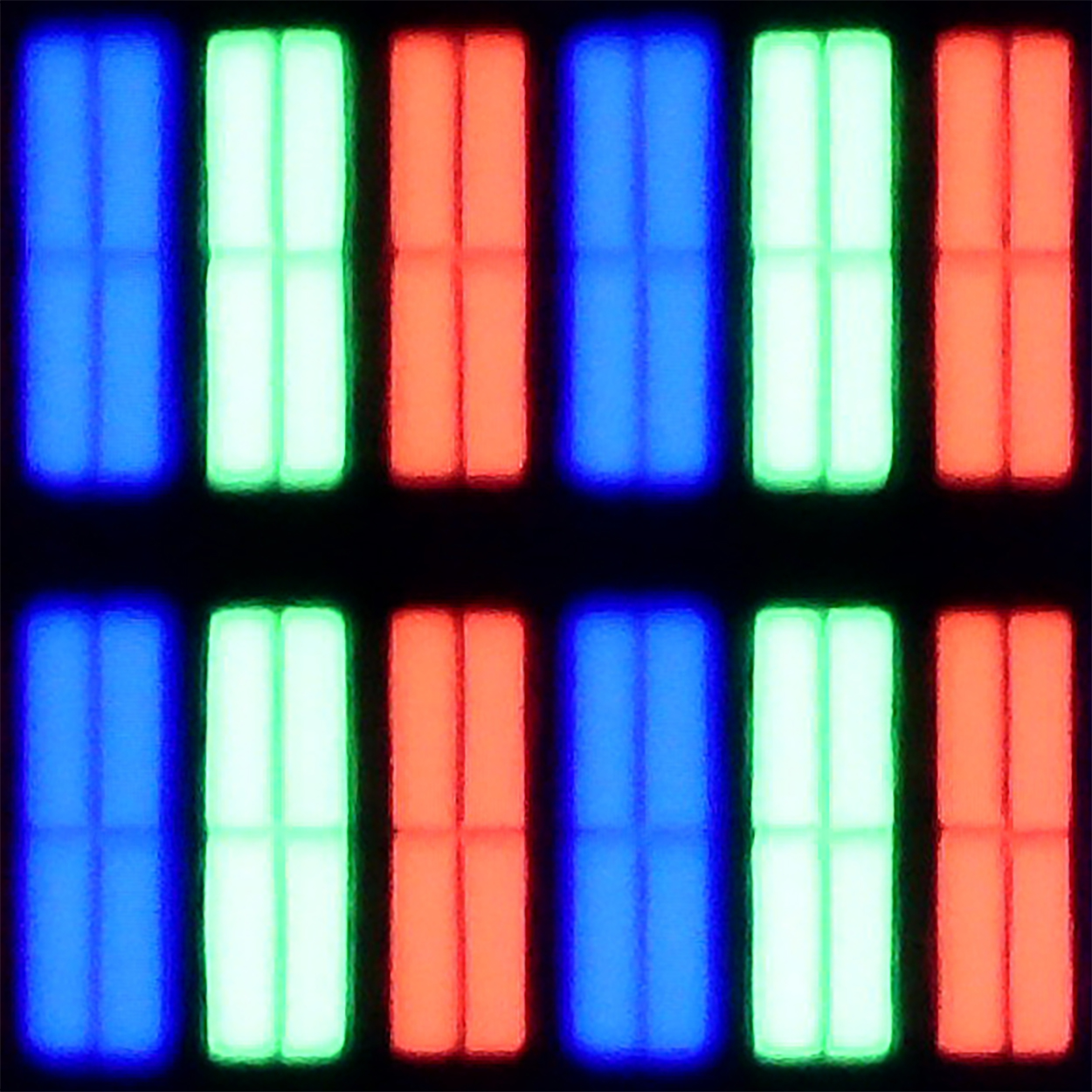
Panel uniformity and thermal imaging:
Backlight Type: White LED

Founder and originator of the "ChooseTV" portal

Journalist, reviewer, and columnist for the "ChooseTV" portal

